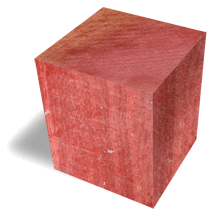
Pink Ivory
Pink Ivory, scientifically Berchemia zeyheri, is a rare and highly prized hardwood from the Rhamnaceae family, native to Southern Africa, primarily found in South Africa, Zimbabwe, and Mozambique. It grows in dry savannas and woodlands, often on rocky or sandy soils, reaching heights of 20–50 feet with trunk diameters of 1–2 feet, though larger specimens are rare due to its slow growth and historical overharvesting.
The heartwood of Pink Ivory is its most striking feature, ranging from a vibrant pink to a deep reddish-pink, sometimes with shades of magenta, coral, or salmon when freshly cut, though it can darken to a more subdued reddish-brown over time with exposure to light. The sapwood is a pale yellowish-white, sharply distinct. The grain is typically straight to slightly interlocked, with a very fine, even texture and a high natural lustre, giving it a smooth, polished appearance when finished. Some pieces may show subtle figuring, such as faint streaks or small knots, adding to its uniqueness.
Pink Ivory has a density of around 900–1,050 kg/m³, making it an extremely hard, heavy, and durable wood with excellent stability once seasoned. It’s highly resistant to decay, moisture, and insects, thanks to its dense structure, making it suitable for both indoor and outdoor applications. The wood is challenging to work due to its hardness, which can dull tools quickly, and its fine grain can cause tearout if tools aren’t sharp. It glues and finishes well, with oil-based finishes enhancing its vibrant colour, though care must be taken to avoid over-darkening the natural pink hue with excessive finishing.
When worked, Pink Ivory has a mild, pleasant scent, often described as slightly sweet, with no overpowering aroma. In the UK, it’s prized for high-end, small-scale projects like knife handles, pen blanks, jewellery, and decorative inlays, where its vivid colour can be showcased. It’s also used for luxury turned objects, small furniture pieces, and even musical instruments like bagpipe components, where its density contributes to a bright tone. Historically, in Southern Africa, it was reserved for Zulu royalty, used for ceremonial items like sceptres, earning it the nickname “royal wood.”
Pink Ivory is very expensive and rare due to its limited supply and high demand. Berchemia zeyheri is not listed on CITES Appendices, but it’s considered near-threatened in some regions due to overexploitation and habitat loss, with strict harvesting regulations in South Africa to protect remaining populations. In the UK, it’s typically imported in small quantities, often as turning blanks, and its cost reflects its scarcity and beauty. Ethical sourcing is crucial, as its rarity makes it a target for illegal logging. Pink Ivory’s unparalleled colour, hardness, and cultural significance make it a coveted choice for bespoke, high-value woodworking projects.
